Tokyo Tech News
Tokyo Tech News
Published: October 15, 2015
Marking the program's twelfth year, high school students gathered again at Summer Challenge 2015 to tackle a number of complex tasks. Since 2004, Tokyo Tech has been offering opportunities for high school students to experience university-level education at the two-day-three-night event. Each year, tasks await students at a site carefully prepared by Tokyo Tech faculty. Summer Challenge is designed to awaken students' dormant abilities and draw out their individuality through experiments and teamwork.
An ever-evolving program, Summer Challenge 2015 welcomed students from a new participant high school — Tokyo Gakugei University Senior High School — along with students from the usual Tokyo Tech High School of Science and Technology and Ochanomizu University Senior High School. This year, the total number of participating high schools increased to 13, bringing in 64 students, 28 of whom were female. All of these were record-high numbers. This year, students gathered at Ranzan town in Saitama prefecture to enjoy the intellectual challenge.
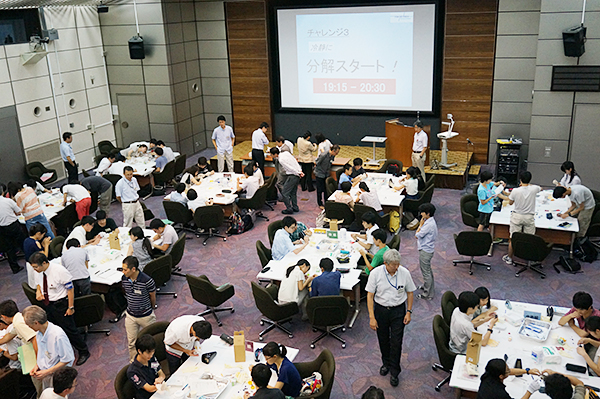
Working in teams
Dates:
August 2 to 4, 2015
Place:
National Women's Education Center of Japan in Ranzan town, Saitama prefecture
Number of participating students:
64
Tokyo Tech High School of Science and Technology: 35
Ochanomizu University Senior High School: 9
Tokyo Gakugei University Senior High School: 10
Other high schools: 10
Number of participating faculty:
41
Tokyo Tech: 23
High school teachers: 18 (from 12 high schools)
Number of participating administrative staff:
9
Total number of participants:
114
Kyoko Yamamuro
Professor, Department of Social Engineering, Graduate School of Decision Science and Technology
As an ice-breaker, the students experienced a popular Tokyo Tech class — Column land — evaluating short anonymous pieces of writing prepared in advance by all participants. This year's topic was simply "flower," and there were works of great individuality: one about a sunflower, another about a butterfly. A piece about wheat flour took everyone by surprise and won first prize. Yamamuro's approach made the students more familiar and comfortable with each other and teams got off to a flying start.
A great way to get to know each other's personality while touching on every individual's sensitivities.
Kenji Ohta
Lecturer, Department of Earth and Planetary Sciences, Graduate School of Science and Engineering
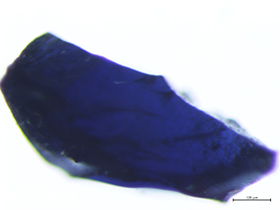
Hydrous ringwoodite
Challenge 2 took students on a journey to the center of the Earth, and introduced the phenomena within the high-pressure, high-temperature interior of our planet.
"With this device, we are going to apply pressure and make room-temperature ice! Check it out, the ice sinks in water!" Ohta demonstrated the mantle's characteristics with dash and spirit.
Many might think of swirling magma under their feet, but the upper mantle, down to about 410 km deep, is actually packed with olivine glowing green like a jewelry box. Deeper in the mantle transition zone is a type of impounding lake where water is compressed into the rock.
Students were pleased to calculate the amount of this water and find it far exceeds the water in our oceans!
Addressing the theme of geology through basic mathematics and chemistry was a nice breath of fresh air.
Mitsutoshi Ueda
Associate Professor, Department of Metallurgy and Ceramics Science, Graduate School of Science and Engineering
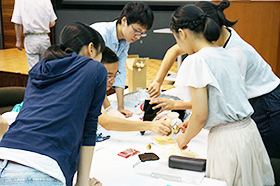
Team disassembling a metronome
This year's first evening event was the annual "Disassemble three things around you" challenge. The first item to take apart was a metronome, an item all music enthusiasts are familiar with.
"Piece by piece, disassemble the metronome and understand the mechanics that helps provide us with rhythm," Ueda gave directions to students. Uncertainty regarding the mechanical components such as the coiled metal plate in the metronome showed that students' interests are perhaps changing with the times.
The second disassembled item was a tally counter, often used in activities such as bird-watching. This helped students understand the mechanism behind carrying numbers.
The last item was a small electric motor manufactured by Mabuchi Motor Company. The observing high school teachers seemed more fascinated by this disassembly than the students.
After overcoming various challenges in teams, the students gave 5-minute presentations of their findings the next morning. This final challenge, one of time management, nicely wrapped up the session.
Disassembling anything and everything to our hearts' content — a true pleasure!
Tomohiko Uyematsu
Professor, Department of Communications and Computer Engineering, Graduate School of Science and Engineering
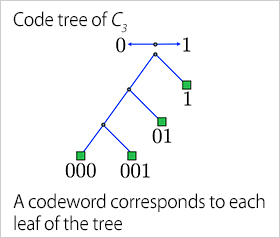
Code tree structure
Organizing chaotic reality and communicating it to others is an important function of languages. A language can be simplified into two codes — 0 and 1 — without commas or full stops. With some ingenuity, a system to find delimiters in a very long sequence of 0s and 1s can be created.
In Challenge 5, Uyematsu vividly described the wisdom and difficulties of predecessors in attempting to develop the ultimate artificial language for computer communication in the form of faster, more accurate, and more compact code.
It was invigorating to hear students gradually coming to realizations as the professor gradually gave them hints.
Ichiro Yamanaka
Professor, Department of Chemistry and Materials Science, Graduate School of Science and Engineering
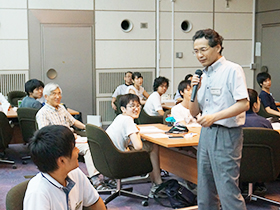
Plenty of laughter during the lecture
"What's this?" students were puzzled when they were suddenly handed a black, flat, coin-shaped material. "Teams, try giving me an answer about what you think this is. I expect wild ideas such as mobile black holes and the like. But please refrain from eating it," Yamanaka's relentless jokes drew constant laughter from the students.
The lecture moved on to cell mechanisms and fuel cells which produce a chemical reaction of hydrogen and oxygen through platinum catalysis. "Media reports often say that fuel cells are environmentally friendly, however technically speaking that is not correct. Nevertheless, fuel cells exhibit high energy efficiency and require plenty of further research," Yamanaka continued.
After an intense lecture, students finally got the answer to the initial mystery. "The unknown material is the conjugant of Nafion and platinum/carbon — basically, the brain of fuel cells."
I was impressed by the professor's ability to smoothly bring high school students to a university level of study.
Shunichiro Ogura
Associate Professor, Graduate School of Bioscience and Biotechnology
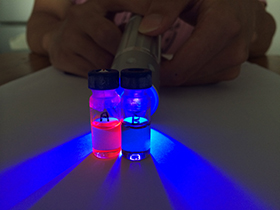
Cancer cells producing red fluorescence
After inquiring whether the famous Japanese cartoon character Doraemon is a "creature", Ogura moved on to more challenging questions, "What is the definition of a creature? Once a cell dies, what state is it in?"
The lecture eventually brought students to cancer cells, the main enemy of mankind. When aminolevulinic acid is administered to patients, a material called protoporphyrin IX accumulates in cancer cells and glows red when irradiated. Thanks to this material, cancer cells can be completely removed during an operation.
"Our dream is to develop an over-the-counter cancer test kit." The professor's enthusiasm as a scientist left a long-lasting impression on many of the students.
It was an interesting non-medical, non-pharmaceutical approach to medical care.
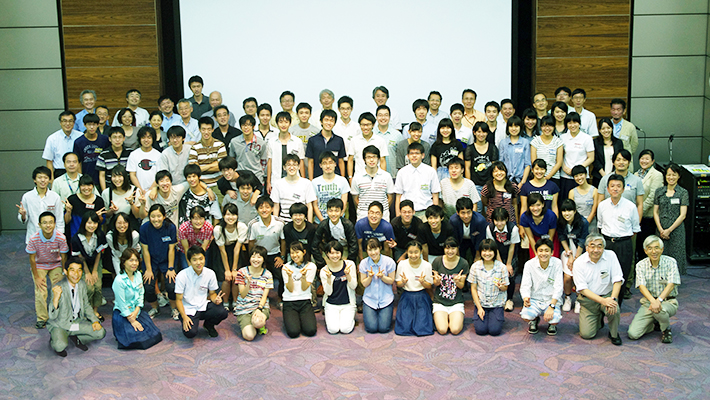
Summer Challenge 2015 participants